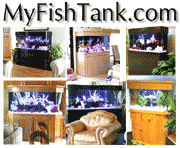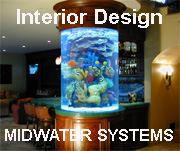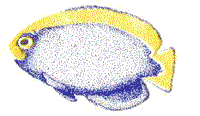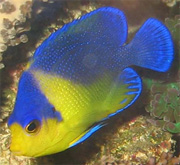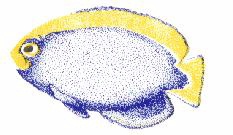|
Basic
Filtration for the Saltwater Fish Tank
Ok, now you have decided on what size tank you are going to set, up
now its time to decide on the basic equipment that you will need to operate
the tank properly. Keep in mind that these pieces of equipment are the
' life support system ' for your fish.
There are three ( 3 ) basic types of filtration; Mechanical, Chemical
and Biological that need to be incorporated into an aquarium;
Mechanical filtration means that
some sort of grid, mesh, or pad is responsible for trapping out particles.
This may sound silly but a good example of mechanical filtration is your
screen door, it stops the bugs from coming in but allows the breeze to
pass through. A filter pad does the same thing, it stops particles ( of
a certain size ) from passing through but allows the water to pass through.
There are many forms of mechanical filtration; sponges, filter pads,
and pleated cartridges are just a few. The density of this material determines
the size of the particles that will become trapped within this media, and
its need or frequency to be cleaned or replaced.
Corner Filters, Power Filters and Canister Filters all contain some
form of mechanical filtration. A corner filter uses the white floss material.
A power filter utilizes a cartridge, sponge or pouch, and a canister filter
incorporates a filter sleeve, floss, sponge or pleated cartridge.
Chemical filtration is the use of
a media that has the ability to attract, 'adsorb', trap, or exchange itself
with other compounds.
Activated carbon has a unique property that adsorbs oppositely charged
( non polar ) organic compounds into itself. Think of it as a Organic
Magnet. These organics can be the compounds that cause water to become
yellow, or give the water an odor. Activated carbon also helps remove heavy
metals such as iron, lead and copper.
There are many other forms of chemical filtration such as Zeolites,
Ion Exchange and Molecular Filter Pads that are helpful in removing chlorine,
ammonia, nitrate and phosphate.
Chemical filtration media is usually contained within a bag or pouch
as it is usually in a granular form, and is placed somewhere in the filter
system to maximize its exposure to the water.
Biological filtration the use of
bacteria's that breakdown, or convert, the chemical form of fishes waste
into lesser toxic forms. One could consider the biological filter as a
living filter.
There are many, many forms of bacteria that collect in the aquarium,
some good, some bad, but the most important are the Nitrifying Bacteria.
These nitrifying bacteria are responsible for breaking down the fishes
fecal and urine compounds into their basic compounds, namely Ammonia. Without
these bacteria's the fish would not survive the living in their own waste.
The most commonly referred to bacteria's in a biological filter are
Nitrosomonas and Nitrobacter. These bacteria's form naturally in the aquarium,
usually introduced via the excrement of the fishes. They develop independently
of each other one after the other. The development time for a biological
filter is approximately 30 to 45 days, which is sometimes referred to as
the 'break-in period' or the 'cycle', and it does not begin until the addition
of fish, or some form of life, is added. Its during this time that the
toxicity of the water will reach its highest, and why its strongly suggested
that one select 'inexpensive or hardy' fish such as Damsel's.
Where do these bacteria live ? On everything ! The area with the greatest
concentration of bacterias is where the water, oxygen, and waste pass through
the most.
The most common form of biological filtration is called an Undergravel
Filter. This is a grid that is placed at the bottom of the aquarium
and has about 1" of gravel placed over it. Water is then drawn through
the gravel into the grid and passed back into the aquarium, which allows
the bacteria that have grown in the gravel to become exposed to the waste
in the water.
An undergravel filter may be driven by Uplift Tubes that have bubbles
percolating up the tube which in turn cause water from the grid to be pulled
upwards inside the tube. There may also be Power Heads which are submersible
pumps that suck the water up the tubes. Regardless of the manner which
the water is drawn up the tubes what is important is that the water above
the gravel is sucked down through the gravel into the grid and recalculated
back above the gravel. This will maximize the exposure of the bacteria
in the gravel to the waste within the water.
Another form of Biological filtration is the Wet-Dry
or Trickle filter. This type of filter is generally located externally
to the aquarium whether it be on the backside or underneath the aquarium.
The trickle filter draws its water from the surface of the aquarium
and after it is routed through 'pre-filter' it is distributed, or trickled,
over a filter media that is either similar to hair curlers ( called bio-balls
), or a spiral wound filter pad ( called DLS ), or a revolving cylinder
( called a Bio-Wheel ).
The advantage to a wet-dry trickle filter is the greater exposure of
the water and the bacteria to the air/ oxygen as the bacteria oxidize the
waste. The greater the amount of oxygen available in the water the greater
the effectiveness of the bacteria.
Two other important pieces of equipment are an Air Pump and a Heater.
All aquariums need an oxygen supply. The most common form of accomplishing
this is to include an air pump. The air pump discharges its air via an
airline into the aquarium where an 'air stone or air diffuser' breaks the
air into many small bubbles that percolate in the water and as they burst
at the surface they will help increase the dissolved oxygen in the water.
The heater helps to increase or maintain a specific water temperature.
Heaters are intended to be partially or completely submersed, and are generally
adjustable as the the temperature setting. The general rule of thumb is
one needs a heater that generates 3 watts per gallon of aquarium water.
In addition the the filter equipment on a saltwater aquarium one needs
the following tools to help maintain and monitor the marine environment
;
A Hydrometer, which is used to measure the amount of salt in, or salinity
of, the water. This can be in the form of a Floating Glass Hydrometer,
a Plastic " needle in a box " Hydrometer. Both versions will give a reference
to the salinity / specific gravity of the water by raising or floating
higher in the water as the salinity increases.
Test Kits, specifically an Ammonia ( NH4 ), Nitrite ( NO2 ), Nitrate
( NO3 ) and pH test kit are extremely useful. The results of these tests
will give you insight into the chemical / biological environment of your
aquarium.
|
